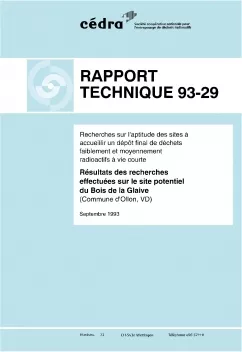
Technical Report NTB 93-29
Recherches sur l'aptitude des sites à accueillir un dépôt final de déchets faiblement et moyennement radioactifs à vie courteRésultats des recherches effectuées sur le site potentiel du Bois de la Glaive (commune d'Ollon, VD)
This report forms part of the supporting documentation for the low- and intermediatelevel radioactive waste repository site selection procedure. The aim of the report is to present the site-specific geological data used as a basis for evaluating the long-term safety of a repository at Bois de la Glaive. These data also form a key component of another report, published simultaneously with this one, which compares all four potential repository sites (Bois de la Glaive, Oberbauenstock, Piz Pian Grand and Wellenberg, NTB 93-02).
As a result of difficulties encountered in obtaining the necessary licences, the geological investigations at Bois de la Glaive took significantly longer than those at the other three sites being evaluated. Reference is therefore made both to the status of investigations in 1988 (documented in NTB 88-17) and to work carried out since then (completed in March 1993), the emphasis in this report being on the latter.
Following an introductory section dealing with goals and procedures, the third chapter documents the work carried out at the site. Chapter four then provides a general overview of the geography and geology of Bois de la Glaive. The subsequent chapters deal with local geology, the mineralogy and geochemistry of the potential host rock, the hydrogeology of the site, the hydrochemistry and isotope hydrogeology at the surface and in the boreholes and relevant aspects of long-term safety. A separate chapter is devoted to the results of the field work carried out during winter 1992/93.
A short synthesis then outlines the conceptual model evolved for Bois de la Glaive. The information obtained at Ollon over the last ten years is also discussed and the relative advantages and disadvantages of the site are weighed up.
The scope of the investigations carried out, and the level of information they have provided, allow Bois de la Glaive to be compared objectively with the other three potential sites. In summary, it can be said that the results of the field investigation programme have brought a significant advance in the understanding of the site. The existence of an extensive gypsum-anhydrite formation was confirmed, as was the assumption that, beneath the 20 – 40 metre thick gypsum cap-rock, the vertical extent of the anhydrite is probably in the order of several hundred metres. In addition, the investigations have also revealed the complex geological structure of the region, which makes it difficult to predict geological conditions at depth on the basis of a few exploratory boreholes and limited geophysical measurements. It is now clear that providing a positive demonstration of the suitability of the Bois de la Glaive site is not without its problems and would certainly involve a high investment of time and investigation effort.
